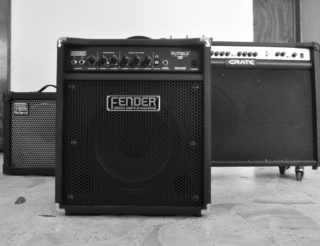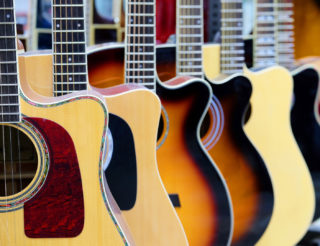The Andalusian Cadence: The Most Common Guitar Chord Progression You Have Never Heard Of
Author: Miguel Marquez

Table of Contents
THE ANDALUSIAN CADENCE
In this article I’ll be discussing one of my favourite chord progressions, one that interestingly enough, isn’t likely to be heard in most of today’s mainstream pop music but is still very popular in guitar-heavy genres. The progression in question is, as the title says, the so-called “Andalusian Cadence”. The name makes a lot of sense when you realize how important this progression is for Flamenco music. That said, you can find plenty of pieces from the Baroque period of classical music that implement the structure of this chord progression. Moreover, this progression happens to be found in different kind of genres and is even fairly common in metal, specially in the European metal scene
STRUCTURE OF THE ANDALUSIAN CADENCE
For the sake of simplicity we’ll be playing all of the examples in the key of A minor, which is easier for beginners to practice in. If you have read any articles or lessons on chord progressions, you are probably familiar with the Roman numeral system, which assigns an individual number to each degree of a diatonic scale. In this case:
i – ii – III – iv – v – VI – VII
A – B – C – D – E – F – G
The Andalusian cadence is simply a i – VII – VI – V, wherein the chord built on the fifth degree of the scale is made major.
We’d thus have Amin, Gmaj, Fmaj and Emaj.
The last chord will sound more effective if we turn it into a seventh chord, thus turning it into E7. Notice how you simply need to add just one finger to change the sound of the chord dramatically.
Adding notes to a chord is actually one good way to change not just the sound of a single chord, but the sound of any chord progression.
To make things sound you simply need to modify each chord so as to change its particular color. If you are a beginner, it’s not even necessary to know the theory behind chords. Simply use Uberchord to get possible replacements for each of the chords in the progression. You will notice how you will simply be removing or adding fingers. Those of you reading this article and who happen to have a good grasp of music theory will understand that we’re basically working with so-called tension notes that are added to the chords. If we add diatonic sevenths to each of the chords in the progression we’d get:
Amin7 – G7 – Fmaj7 – E7
But there’s more you can do with it. One cool twist to add to the progression is to make the VI degree (the third chord in this case) a dominant seventh chord, we’d thus have F7 before the E7. This is used in the main progression of an instrumental by Tribe of Gypsies named “Mero Mero Mambo” and it sounds very cool in context.
The Andalusian cadence is more prominent than one may think at first. It is featured in the chorus of Michael Jackson’s “Smooth Criminal” and it also builds the basis for the middle section in Paco De Lucia’s signature track, “Entre dos Aguas”, where this progression is played in the key of E minor.
Another modification gives the progression a more modal sound. Simply replace the VII by a vii chord. You’d thus have Amin – Gmin – Fmaj – E7. This effect sounds even cooler if you make that vii chord a minor 7th or minor 9th chord (I personally do that all the time). You can hear this by the way in a tune by DiMeola / McLaughlin / De Lucia called “Chanela”. This example is in the key of B minor, but the principle applied is the same.
The cool thing about this progression is its simplicity and it’s mainly due to this reason that you can easily play around with it. Let’s explore different ways to play it.
Exercise 1
This is a pretty straight-forward way to play the chord progression. The first ¾ of it might sound familiar to you. The reason being is that they constitute the harmonic background to Jimmy Page’s legendary solo in “Stairway to heaven”.
Exercise 2
This one is a less straight-forward, more syncopated way to play the chords in question. It’s actually the beginning of Carlos Santana’s Corazon Espinado.
Exercise 3
This is a more fresh, probably cooler way to play the chords. I’m no longer playing the “complete” version of each chord, but rather simplified version. This kind of shape is great if you’re into funk or wish to inject some funky nuances into pretty much anything you write.
As you can see, there is a lot that can be done with just four chords. Make sure you try out different shapes for each chord, as the Uberchord app suggest several options for every chord you browse. I have used rather simple shapes for this article, but there is so much more you can do once you start exploring different versions of the same chord.
I hope you liked this article. Feel free to check out my efforts as a guitar player on my Facebook page and on YouTube.
There is a lot of great Spanish guitar music that will require knowledge of many chord shapes as well as some music theory. This is because the music is too difficult to learn by just memorizing the finger placements! Our blog has lots of articles that can help, and cover a range of topics like essential chords, sg vs strat playability, and chords maybe tomorrow.








You have a bug in your page on my browser, which is Firefox. It occurs in more that one place:
!function(e,r,d){var t,c=e.getElementsByTagName(r)[0];e.getElementById(d)||(t=e.createElement(r),t.id=d,t.src=”https://uberchord-backend.firebaseapp.com/uberchord-embed-sdk.js”,c.parentNode.insertBefore(t,c))}(document,”script”,”uberchord-jssdk”);
Fixed! Thanks, Mike! :-)